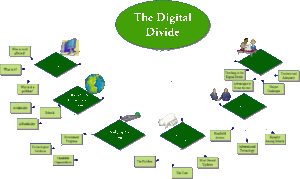Back to: Computer Science JSS 3
Welcome to class!
In today’s class, we shall be talking about the limitations of the old digital economy. Please enjoy the class!
Digital divide – Limitations of The Old Digital Economy

Imagine a world where information flows freely, connecting people and ideas across continents in an instant. This is the promise of the digital age, a world driven by the power of technology. However, for many, this dream remains unrealized, trapped in the shadows of a persistent inequality known as the digital divide.
The digital divide refers to the gap between those who have access to and can effectively utilize information and communication technologies (ICTs) and those who are marginalized due to lack of access, affordability, skills, or infrastructure. This divide has profound implications, not only for individuals but also for the way economies function.
Limitations of the Old Digital Economy:

The “old” digital economy, which largely emerged in the late 20th and early 21st centuries, was characterized by several limitations that exacerbated the digital divide:
Focus on physical infrastructure: Early investments prioritized building physical networks like cables and towers, neglecting rural areas and disadvantaged communities. This left many without basic internet access, the essential first step in bridging the divide.

Digital literacy gap: Even with access, many lacked the skills and knowledge to navigate the digital world effectively. This hampered their ability to utilize technology for education, communication, and economic opportunities.
Costly technology and services: Early internet access and devices were expensive, further excluding low-income individuals and communities. This created a vicious cycle where those who could afford to participate in the digital economy benefited most, further widening the gap.
Limited inclusivity: The design and development of technology often overlooked the needs of diverse populations, including people with disabilities and those from marginalized communities. This further perpetuated existing inequalities in the digital space.
Consequences
These limitations had significant consequences for both individuals and society:
- Economic exclusion: Lack of digital skills and access limited employment opportunities in the increasingly digital economy, widening the wealth gap and perpetuating poverty.
- Educational disparities: Unequal access to online learning resources and tools exacerbated educational inequalities, particularly for students from disadvantaged backgrounds.
- Social isolation: Lack of connectivity marginalized individuals and communities, hindering communication, access to information, and participation in civic life.
- Democratic deficit: Unequal access to digital platforms and participation in decision-making processes and undermined democratic accountability.
Possible Solutions
Recognizing these limitations, efforts are underway to bridge the digital divide and create a more inclusive digital economy. These include:
- Expanding infrastructure: Investments in satellite internet, wireless technologies, and community networks are bringing connectivity to remote areas.
- Promoting digital literacy: Initiatives focus on providing training and education programs to equip individuals with the skills needed to thrive in the digital world.
- Making technology affordable: Subsidies, public-private partnerships, and innovative financing models are making technology and internet access more affordable for low-income communities.
- Designing for inclusivity: Developers are increasingly considering the needs of diverse users, creating accessible technologies and platforms that cater to a wider range of abilities and backgrounds.
The digital divide is not an inevitable consequence of technological advancements; it is a product of choices and priorities. By acknowledging its limitations and actively working towards bridging the gap, we can create a more equitable and inclusive digital future where everyone has the opportunity to participate and benefit from the transformative power of technology.
What you can do to become part of the solutions:
- Get involved in initiatives that promote digital literacy and access in your community.
- Advocate for policies that bridge the digital divide and ensure inclusive technology development.
- Use your voice to raise awareness about the importance of a more equitable digital future.
We have come to the end of today’s class. I hope you enjoyed the class!
In the next class, we shall be discussing the definition and terminology of database.
In case you require further assistance or have any questions, feel free to ask in the comment section below, and trust us to respond as soon as possible. Cheers!
Question Time:
Multiple Choice:
Which of the following is NOT a limitation of the old digital economy that contributed to the digital divide?
- a) Focus on physical infrastructure
- b) High cost of technology and services
- c) Emphasis on digital literacy training
- d) Limited inclusivity in tech design
The lack of internet access in rural areas is primarily due to:
- a) Insufficient government regulation
- b) Preference for wired connections
- c) Difficulty implementing wireless technologies
- d) Low demand for internet services
Short Answer Questions:
- Briefly explain two negative consequences of the digital divide on educational opportunities.
- Describe one initiative aimed at promoting digital literacy in developing countries.
- What is the meaning of “inclusive technology design” in the context of bridging the digital divide?
